|
 |
 |
|
Clams
|
 |
 |
|
Clams, or bivalves as they are more technically known because they have two shells or valves, have been harvested in Netarts Bay for hundreds of years. They were a staple of Native Americans living between the Capes, especially around Netarts Bay, long before the arrival of European-American settlers.. Their middens are packed with the shells of cockles and butter clams. Still plentiful today, these clams and others are favorites of residents and visitors alike. There are many species of clams and other bivalves between the Capes, but only about a dozen are typically harvested.
There are four cautions before gathering clams:
- 1. Check the shellfish regulations found in Oregon Sport Fishing Regulations published yearly by Oregon Fish and Wildlife.
- 2. Check for collection closures due to Amnesic Shellfish Poisoning (ASP) and Paralytic Shellfish Poisoning (PSP). ASP and PSP are caused by the accumulation in shellfish of biotoxins contained in certain phytoplankton on which shellfish feed. Eating shellfish contaminated with these biotoxins can cause illness and even death. Call the Oregon Shellfish Hotline at 1-800-448-2474 or go on-line to http://egov.oregon.gov/oda/
- 3. Be aware of sections of the Netarts Bay that are leased to oyster growers and Oregon State University. These areas are off limits to digging and foot traffic.
- 4. Watch for the incoming tide. It is easy to get stranded if you are not paying attention.
The Butter Clam (Saxidomus gigantea), also known as the Smooth Washington Clam, Martha Washington, and Quahog, is probably the favorite from Netarts Bay. This clam has thick, oval shells, sculptured with fine concentric ridges, that are chalky-white except when stained black with ferrous sulfide, present in sediments with little oxygen. It has an external hinge ligament, and the shells are often slightly gaped, showing a frilly-looking mantle fold. It lives about a foot deep in sandy sediments and can be dug easily at low tide with a shovel. If the tide flat is exposed, look for a depression in the sand about half an inch across. You can stick your finger about an inch into this hole before you find it plugged with sediment. This is the spot where the clam extends its neck (siphons) for breathing and feeding when the tide is in. A good digging area is inside the north end of Netarts spit, directly west of the boat launch. Butter clams are considered the best chowder clams. They have a large foot, two large adductor muscles, and a meaty neck. The whole clam can be eaten, but some people like to clean out some of the gonad, digestive gland, and the crystalline style, the gelatinous worm-looking organ. It is also wise to clip off and discard the black ends of the siphons because they can acc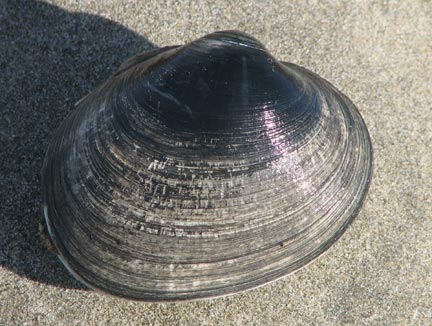 umulate biotoxins. umulate biotoxins.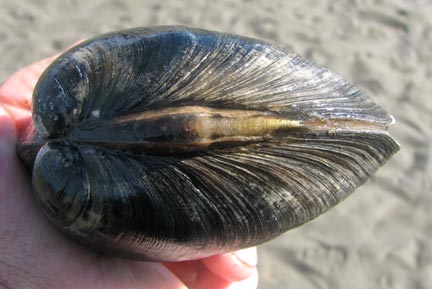 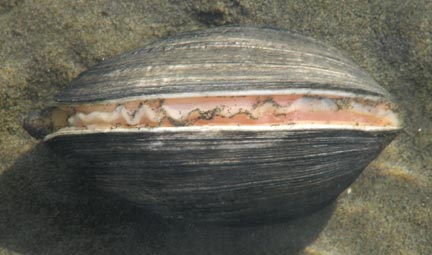
|
|
|
 |
|
Nuttall's Cockle (Clinocardium nuttallii), because of its short neck, lives under just a few inches of sand and can be harvested with a clam rake, a garden rake, or a shovel. Also known as the heart cockle, basket cockle, and cockle clam, its species is named after Thomas Nuttall (1786-1859), an English biologist who spent a large part of his career exploring the America, including the Pacific Northwest, and whose name is associated with several clams. Its thick, rounded shells, up to four inches across and colored yellowish tan with brown or reddish accents, radiate 34 to 38 distinct ribs, crossed by fine growth rings. A strong burrower with a powerful, muscular foot, it has the ability to escape its major predator in the bay, the many-rayed sunflower star Pycnopodia helianthoides, by using its foot to almost leap away. Nuttall's cockle can live up to 16 years. Though tasty, it has a strong flavor and is mainly used in chowder and fettuccine. To open and shuck cockles easily, blanch them first in boiling water for about 20 seconds. You can find cockles in the sand and mud shallows on the east side of the bay
|
|
 |
 |
|
The Pacific Gaper Clam (Tresus nuttallii) is the largest and deepest burrowing clam in the bay. Also called the horse clam, it can reach eight inches long and burrow down to three or more feet. Its shell, when not stained, is creamy white and partly 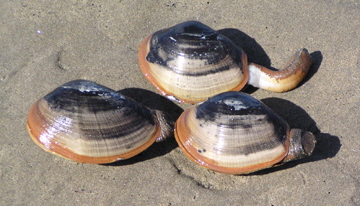 covered with a brown varnish-like chitinoid coating called a periostracum.The two shells gape on the posterior end where the neck protrudes, hence its common name. The clam can also be identified by the internal hinge ligament that fits into a pair of spoon-shaped depressions in the shells called chondrophores. The large neck, the meatiest part of the clam, has fused incurrent and excurent siphons and is sheathed with part of the periostracum. The tip of the neck bears two hard, leathery plates. These gaper clams are found in various parts of the bay, usually clustered in sandy sediments. The neck hole is an inch or more across, and if you stick in your finger, you can feel the hard plates just before the siphons is retra covered with a brown varnish-like chitinoid coating called a periostracum.The two shells gape on the posterior end where the neck protrudes, hence its common name. The clam can also be identified by the internal hinge ligament that fits into a pair of spoon-shaped depressions in the shells called chondrophores. The large neck, the meatiest part of the clam, has fused incurrent and excurent siphons and is sheathed with part of the periostracum. The tip of the neck bears two hard, leathery plates. These gaper clams are found in various parts of the bay, usually clustered in sandy sediments. The neck hole is an inch or more across, and if you stick in your finger, you can feel the hard plates just before the siphons is retra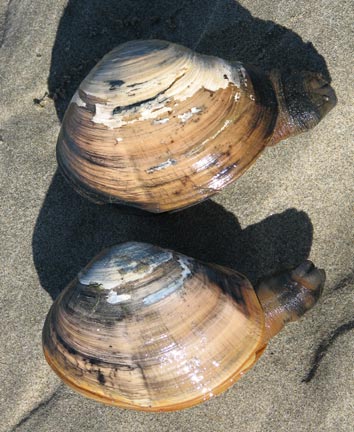 cted. You may also get hit with a jet of water that is expelled when the clam is disturbed. When digging for the clam, be careful not to break the fragile shells. The neck, after tenderizing, is good fried or in chowder, but should be dipped in boiling water first to aid in removing the periostracum. The leathery plates can be clipped off. When cleaning the clam, you will likely find one of three species of commensal pea crabs, Pinnixa faba, Pinnixa littoralis, or Fabia subquadrata in the mantle cavity. They also inhabit other clams. cted. You may also get hit with a jet of water that is expelled when the clam is disturbed. When digging for the clam, be careful not to break the fragile shells. The neck, after tenderizing, is good fried or in chowder, but should be dipped in boiling water first to aid in removing the periostracum. The leathery plates can be clipped off. When cleaning the clam, you will likely find one of three species of commensal pea crabs, Pinnixa faba, Pinnixa littoralis, or Fabia subquadrata in the mantle cavity. They also inhabit other clams.
Another gaper clam, the Fat Gaper (Tresus capax), with a rounder more robust shell, also occurs in the bay, but is not as common. The tip of its siphon does not have the hard, leathery plates. Its shells, probably from offshore populations, are commonly washed up on the beaches outside the bay.
|
 |
Fat Gaper
|
|
|
 |
 |
 |
 |
|
The Softshell Clam (Mya arenarea) is a naturalized import from the east coast, possibly introduced in 1869 with shipments of oysters to San Francisco. It is found in scattered groupings in intertidal sand and muddy areas about four to twelve inches below the surface. It may be up to four inches long with a chalky-white, brittle shell that has a periostracum around its margins. Its left valve or shell (the posterior of the clam has the neck) has a distinct internal protuberance, the chondrophore (arrow), which sticks out from the hinge. Softshell clams do well in low saline waters, so they may be prevalent where creeks flow into the bay. Because of their fragile shells, they are easily broken when dug. Softshell clams are an east coast favorite, steamed, fried, and in chowder. Nearly all those in Netarts Bay contain pea crabs which makes them not quite as delectable.
|
|
|
(see Mya arenaria Linnaeus, 1758)
|
|
|
 |
 |
|
The Pacific Little Neck Clam (Leukoma staminea) is the favorite west coast steamer clam. It has a thick, oval, chalky-white to brownish shell with narrow radiating ribs and concentric growth ridges. This is a fast growing and fairly long living clam, sometimes reaching as 16 years. Its growth rate tends to slow with age. It has a short neck with fused siphons and burrows from four to ten inches into sandy, muddy, and sometimes gravely sediments. It, like some of the other clams, is found in patches and is not very common. It is usually dug with a shovel, but shallow populations can be raked out Small, two to three-year-old clams are best for steaming. They are eaten whole.
You may occasionally find the Japanese Littleneck or Manila Clam (Venerupis phillppinarum), which resembles the Pacific Littleneck but is more oval and has colored streaks on its shell, about four inches deep in
|
|
|
 |
sandy to gravely sediments. It was introduced from Japan to the West Coast in the 1930s.
|
 |
 |
|
You can occasionally find the Sickle Jackknife Clam (Solen sicarius), which resembles a razor clam, nestled in the eel grass beds of Netarts Bay, buried up to a foot and a half deep in the silt, where it prefers a sheltered habitat. It is four to five inches long, has a dark brown periostracum, and a pearly white inner shell. Its hinge is near the anterior end. It is an aggressive digger when disturbed. It is edible but is not abundant. Its range is from Alaska to Baja Calfornia.
|
|
|
 |
 |
|
A recent arrival to Netarts Bay is the Dark Mahogany Clam (Nuttallia obscurata). Also called the Purple Varnish Clam, it is native to Japan, Korea, and possibly China. It entered British Columbia around 1992 in ballast water, rapidly spread southward, and took up residence in Netarts Bay probably after 2000. It is now common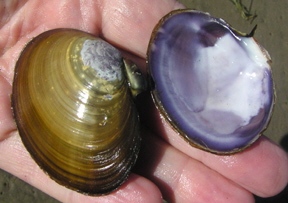 in most Oregon estuaries. It has flat, oval shells, slightly elongated on the rear end, a prominent ligament, and can be most easily recognized by its shiny dark brown periostracum that makes the clam look like its been painted with spar varnish. The inside of the shell is a vivid purple, unlike any other local clam. It has no single neck; siphons are separate, and it is both a suspension and deposit feeder. There is a dense concentration of these clams on Netarts Spit, directly across the bay from the boat launch, high up in the intertidal zone. You do not need a very low tide for harvesting. Look for small siphon holes close together. They bury in sand about six to ten inches deep. Wear gloves if you dig them with your hands. The edges of the shells are sharp. They are excellent steamed or seasoned and grilled on the halfshell. The digestive gland is a dark green and can be remove with a flick of the thumb when cleaned. in most Oregon estuaries. It has flat, oval shells, slightly elongated on the rear end, a prominent ligament, and can be most easily recognized by its shiny dark brown periostracum that makes the clam look like its been painted with spar varnish. The inside of the shell is a vivid purple, unlike any other local clam. It has no single neck; siphons are separate, and it is both a suspension and deposit feeder. There is a dense concentration of these clams on Netarts Spit, directly across the bay from the boat launch, high up in the intertidal zone. You do not need a very low tide for harvesting. Look for small siphon holes close together. They bury in sand about six to ten inches deep. Wear gloves if you dig them with your hands. The edges of the shells are sharp. They are excellent steamed or seasoned and grilled on the halfshell. The digestive gland is a dark green and can be remove with a flick of the thumb when cleaned.
|
 |
 |
|
Macoma Clams come in several species in the bay. All have separated incurrent and excurrent siphons and are predominantly d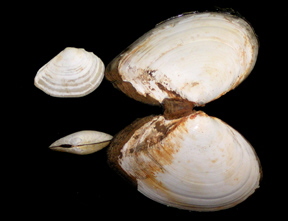 eposit feeders, vacuuming up detritus with the incurrent siphon from the surface of the sediment.Macoma secta (right in picture), the white sand macoma, up to four inches long, is the largest. Its thin shells, marked by shallow concentric growth rings, have no radial ridges except a posterior crease on each valve that runs from the umbo to the shell margin. The hinge is external and short. It is found buried at least eight inches deep. Macoma nasuta (left in picture), the bent-nose macoma, is small, not much more than a couple of inches long, but is the most distinctive macoma because its valves are bent to the right at the posterior end and its siphons are orange. It is common in Netarts Bay and can live in sediments that range from clean sand to those that are very muddy, anaerobic, and noxious. Macoma inquinata is similar in size but without the bent shells and its siphons are yellowish. Macoma balthica, the baltic macoma, is little more than a half inch long and fairly round. All the macomas, if large enough, are edible and make good steamers. eposit feeders, vacuuming up detritus with the incurrent siphon from the surface of the sediment.Macoma secta (right in picture), the white sand macoma, up to four inches long, is the largest. Its thin shells, marked by shallow concentric growth rings, have no radial ridges except a posterior crease on each valve that runs from the umbo to the shell margin. The hinge is external and short. It is found buried at least eight inches deep. Macoma nasuta (left in picture), the bent-nose macoma, is small, not much more than a couple of inches long, but is the most distinctive macoma because its valves are bent to the right at the posterior end and its siphons are orange. It is common in Netarts Bay and can live in sediments that range from clean sand to those that are very muddy, anaerobic, and noxious. Macoma inquinata is similar in size but without the bent shells and its siphons are yellowish. Macoma balthica, the baltic macoma, is little more than a half inch long and fairly round. All the macomas, if large enough, are edible and make good steamers.
|
 |
 |
|
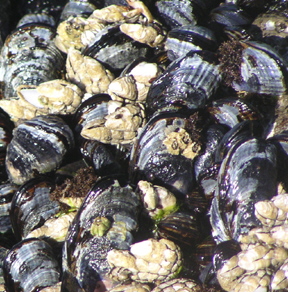 Two species of mussels between the Capes are commonly harvested, the bay mussel (Mytilus trossulus), sometimes called the foolish mussel, and the California mussel (Mytilus californianus). Both live on hard objects, attaching themselves by secreting incredibly strong threads, called the byssus, that are glued to the substrate with a powerful cement. They often occur in dense assemblages, the "mussel beds". Bay mussels prefer quiet waters with lower salinity than ocean water, and are the mussels often served in restaurants as "steamed mussels". They are scattered various locations midway up Netarts Bay. Be careful not to trespass on leased areas. The California mussel (pictured) resides on the wave-swept rocks of the outer coast from Maxwell Point north to Cape Meares and on the rocks at Cape Lookout. It can grow to eight or more inches long. It is usually associated with the gooseneck barnacle Pollicepes polymerus, and together they harbor a number of other invertebrates that find protection within the beds. The ocher star Pisaster ochraceus is a major predator of California mussels. Though they are delicious streamed or roasted, be careful about harvesting these mussels. They are infamous for accumulating toxins that cause PSP, and are used as an indicator for PSP by the Oregon Department of Agriculture. Still, they were a staple of coastal Indians. You can see their shells packed in a midden near the north end of the wayside parking lot in Oceanside. Two species of mussels between the Capes are commonly harvested, the bay mussel (Mytilus trossulus), sometimes called the foolish mussel, and the California mussel (Mytilus californianus). Both live on hard objects, attaching themselves by secreting incredibly strong threads, called the byssus, that are glued to the substrate with a powerful cement. They often occur in dense assemblages, the "mussel beds". Bay mussels prefer quiet waters with lower salinity than ocean water, and are the mussels often served in restaurants as "steamed mussels". They are scattered various locations midway up Netarts Bay. Be careful not to trespass on leased areas. The California mussel (pictured) resides on the wave-swept rocks of the outer coast from Maxwell Point north to Cape Meares and on the rocks at Cape Lookout. It can grow to eight or more inches long. It is usually associated with the gooseneck barnacle Pollicepes polymerus, and together they harbor a number of other invertebrates that find protection within the beds. The ocher star Pisaster ochraceus is a major predator of California mussels. Though they are delicious streamed or roasted, be careful about harvesting these mussels. They are infamous for accumulating toxins that cause PSP, and are used as an indicator for PSP by the Oregon Department of Agriculture. Still, they were a staple of coastal Indians. You can see their shells packed in a midden near the north end of the wayside parking lot in Oceanside.
|
 |
|
 |
 |
 |
 |
 |
 |
|
 |
|
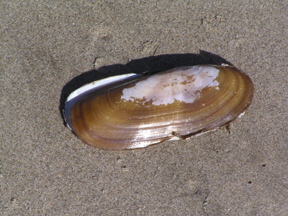 |
|
Pacific Razor Clams (Siliqua patula) probably occur offshore but are not currently shallow enough for digging. Shells are common on the beaches. Many have their periostracums intact, not worn by the surf, indicating that they come from nearby populations. According to a 1958 educational bulletin by the Fish Commission of Oregon, it used to live in the north end of Netarts Bay near the entrance, and local Jim Mundell dug razor clams in Netarts Bay and at Oceanside when he was a kid. For now, you will need to find other razor clam beaches such as Seaside. There are a few on the Cape Meares beach.
|
|
|
|
|
 |
|
|
|
|
The Rough Piddock (Zirfaea pilbryi), in the family Pholadidae, burrows into shale, clay, or firm mud. The anterior half of the shell is covered with concentric ridges of “teeth” used for rasping its way into these hard substrates. It has a large siphon, too big to be withdrawn into the shell; its surface is covered with chitinous tubercles. The clam ranges from Siberia to Baja California. This is a big clam, sometime more than a foot long. It is often mistaken for the Pacific Geoduck (Panopea abrupta), family Hiatellidae, which has
|
|
|
|
been found in Netarts Bay in the past, but may no longer be here. The rough piddock can be dug just off the village of Netarts and probably occurs in other parts of the bay where there are clay outcrops. There is a lot of meat on this clam that can be pounded into steaks and fried or made into chowder. It is not my favorite tasting clam.
|
|
|
|
|
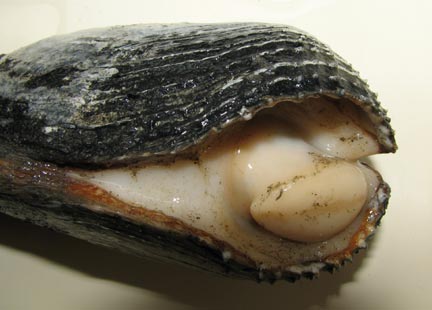 |
|
|
|
|
|
|
|
|

